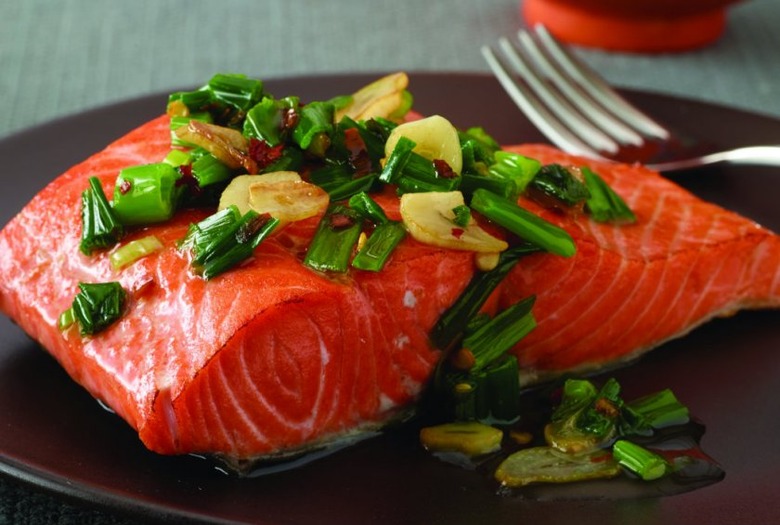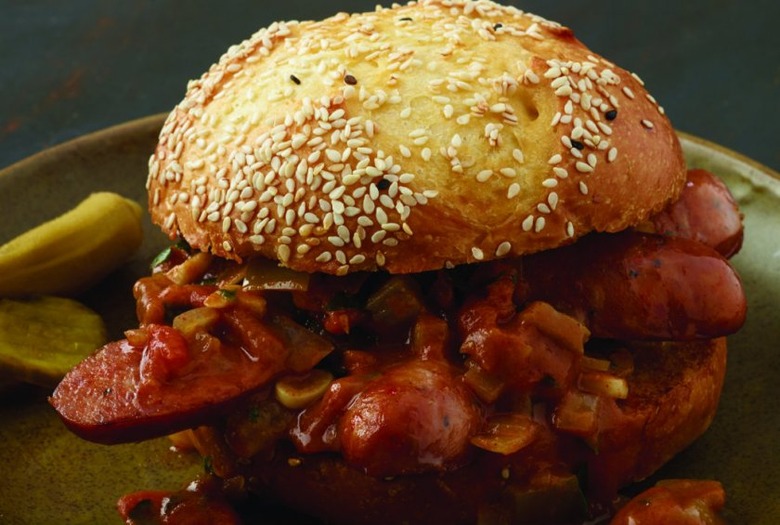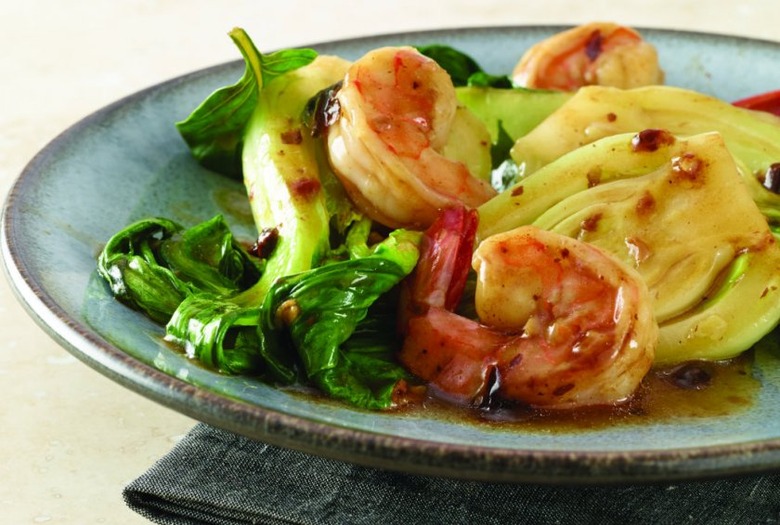What Makes A Perfect Sauce?
We may receive a commission on purchases made from links.
Béchamel, véloute, espagnole, tomato, and hollandaise — the five mother sauces are among the first things you learn in culinary school. Not much has changed in the way of traditional sauces since Marie-Antoine Carême declared the first four sauces the gold standard for sauce-making (Escoffier would later add hollandaise to the list). But there is so much more to exquisite sauce-making than these five classic French bases provide.
Click here for the 5 Sauces That Will Spruce Up Your Cooking slideshow.
In walks Susan Volland; her latest cookbook Mastering Sauces includes so much more than the classic French variations. She celebrates the classic French flavors, as well as embracing the more modern Asian and Latin American flavors that have become commonplace in everyday cooking.
From the subtle chocolate notes in mole to vibrant herbaceous chimichurri to rich fruity wine reductions, the perfect sauce can elevate any dish like simple roast chicken, grilled steak, or sautéed vegetables from bland to exquisite.
We had the opportunity to chat with Volland to find out some of her favorite tips for producing rich sauces and how she hopes reader's will use her new book, Mastering Sauces.
The Daily Meal: Your book goes beyond the basic mother sauces. What are some of your favorite sauces from cuisines outside the French culinary canon?
Susan Volland: There are so many! Part of the reason I wrote the book was because I saw that tikka masala, wasabi mayo, and ranchero sauces were showing up on grocery shelves and family dinner tables way more than classic béchamel or hollandaise. Personally, I'm crazy for Asian sauces — Indian and Thai curries, Vietnamese nuoc mam, and pretty much anything with Korean gochujang.
What are some of your favorite tricks for fixing sauces (seasoning, broken emulsions, etc.)?
Hopefully that won't happen much, but if it does, the first thing to do is consider the ingredients in the sauce. Natural emulsions, like dairy products and eggs are at the root of many sauce problems because with rough handling they will "break" into gritty, oily beads. All it takes is a little education and experience and it won't be a problem. But... in a pinch, a blender and fine strainer can work wonders. Season confidently is one of my three fundamentals of sauce making. To consciously taste your food and then analyze how it stimulates your senses can change everything. If you don't like what you made, why not? Does one taste element, say salty, overpower the others? You might need to boost the acidity with a squeeze of lemon or add some bitterness with more black pepper. Or you may need to rethink your menu and serve a smaller portion of the original sauce, perhaps with a secondary sauce to offer contrast. Professional chefs make mistakes, too. There is a section in the back of the book of some ways you might correct them.
What do you think is the most difficult sauce to master? Why?
I think the most difficult sauce to master is the one you tasted once, fell in love with, and can't seem to duplicate at home. It's brutal. And you always feel like you are somehow failing. Try to give yourself a break from that. Let that sauce be someone else's specialty and work on creating your own instead. For the most part, sauces are easy. At the turn of the last century, the French elevated sauce-making into a rarified environment, but that doesn't mean that the recipes are difficult. A perfect, glossy, wine-scented veal reduction isn't especially hard to make — it's just really time consuming and expensive. A lot of classic sauces rely on masses of cream, butter, and egg yolks and that can make them temperamental. But I think adding super rich ingredients to a sauce are more of a crutch than a flavor booster. Right now, I think a really authentic mole negro would be a real challenge. All those ingredients, taken right to the edge of burnt, and then blended just so. Oh, how I would love to make that right!
How did you boil down the complicated science of cooking to make this book approachable for the home cook?
I had a lot of help. Working with the Modernist Cuisine team was invaluable. I'm not a scientist; I'm just a curious cook who learned a lot from some amazing people. When I was writing the text and ran into a tricky or technical spot that I just couldn't make clear, I would make a friend or family listen to the passage. When their eyes started to glaze over, I knew I needed to strip it way down.
How do you hope readers will use this book?
I wrote the book in the hopes it would appeal to three different kinds of home cooks. One camp needs rock solid recipes. They don't like to experiment or stray from a designated path. My husband was like this when I first met him. He explained, "If I follow a recipe precisely and the food turns out lousy, I can confidently say that it's the recipe that's horrible, not my cooking." The second group likes to use recipes as a starting point and then add their own personal flourishes. I wrote the variation tables for them. They can take a base recipe and create something very original with what they have on hand. Then there are the readers — people who will curl up with a cookbook and read it from cover to cover. My hope is that they will be inspired to put the book aside, and march into the kitchen to cook, but at the very least, they should learn something. My great passion is inspiring people to cook more, and to feel good about it. It seems that everywhere you turn today someone is shouting down from a pedestal "You aren't shopping, cooking, or eating right! Shame on you!" I want more people feel confident and successful in the kitchen. I want them to experience that warm rush that comes from making fresh food for themselves and the people they care about.
Want to try a recipe?
Chinese Crackling Scallion and Garlic Sauce
In some ways, this recipe epitomizes my passion for simple, fresh sauces. It's just hot oil infused with garlic and chiles and loaded with sliced scallions. It's served crackling hot, poured straight from a wok onto whole fish, grilled steaks, roasted potatoes, or even bowls of plain rice. I call it "Chinese" because it reminds me of some of my favorite dishes. It's part sauce, part condiment, and part stir-fry. The steely perfume of a hot wok or cast-iron skillet is an important ingredient in this preparation. I've made this with just about any greens I've had on hand. Try it with chopped ramps, kale, bok choy greens, arugula, or garlic chives. Chopped romaine lettuce works too.
Make sure all of the ingredients are ready before you start. This is a last-minute preparation that is best made and served immediately. — Susan Volland
For the Chinese Crackling Scallion and Garlic Sauce recipe, click here.
Creole Sauce Made with Dark Brown Roux
In Louisiana, a dark brown roux is not just a thickener—it can be a benchmark for who you are as a person. It takes mettle to keep the roux on the stove until the very last minute. The flour must be just this side of burnt, yet with nary a hint of scorching. I will take the pan off the stove repeatedly, thinking I've done it, only to grimace and put it back on for just a tiny bit longer. I'm a babe in the woods when it comes to authentic Cajun and Creole cooking, but I have an appreciation for the unique toasted taste of dishes made with really dark, slow-cooked roux.
This sauce improves after a day or two and freezes well, so keep some on hand to serve as a dollop alongside a fried catfish fillet, to smother a sausage in a bun like a Cajun hot dog, or to simmer with virtually any mix of meats and seafood for a hearty meal with rice.
This version does not call for gumbo filé, powdered sassafras, a natural thickener with a unique slippery texture, because I'm not a fan. Stir a bit in at the end if you like. I usually make my own Cajun spice mix, but to simplify things, here I suggest using a good commercial blend. — Susan Volland
For the Creole Sauce Made with Dark Brown Roux recipe, click here.
Endlessly Adaptable Stir-Fry Sauce
I probably make this sauce more than any other in the book. When I was in culinary school, we were lucky enough to spend a week learning from Yan Kit So, a wonderful cookbook writer and teacher of traditional Chinese recipes and techniques. I have always loved to cook Chinese food—I made my first dim sum feast at age fourteen. From Yan Kit So, I learned to have a better appreciation of simplicity and how good stir-fry technique can add almost as much flavor as sauce.
Since I don't have room to spell out the entire technique in detail, I'll remind you of the key points here: Prep your ingredients carefully and keep them separate. Use a hot wok and be ready to shake and rock it. Infuse your hot cooking oil with aromatics, but don't let them burn. The aromatics you use will greatly influence the taste of the finished dish. Don't assume that everything will take the same amount of time to cook. Don't overcrowd the pan. Err on the side of thin sauces rather than thick.
This recipe is a simple base that can be easily adapted. I use it as written with delicate fresh-tasting vegetables like snow peas, bok choy, or pea shoots. When I want a bolder sauce, I boost it with a dollop of black bean paste or chile sauce. Cornstarch works well as the thickener, but I prefer potato starch because it seems less gluey and the flavor is quite indistinct. Both starches must reach the boiling point, or they will remain opaque and taste raw and starchy.
For the Endlessly Adaptable Stir-Fry Sauce recipe, click here.
Angela Carlos is the Cook Editor at The Daily Meal. Find her on Twitter and tweet @angelaccarlos.


